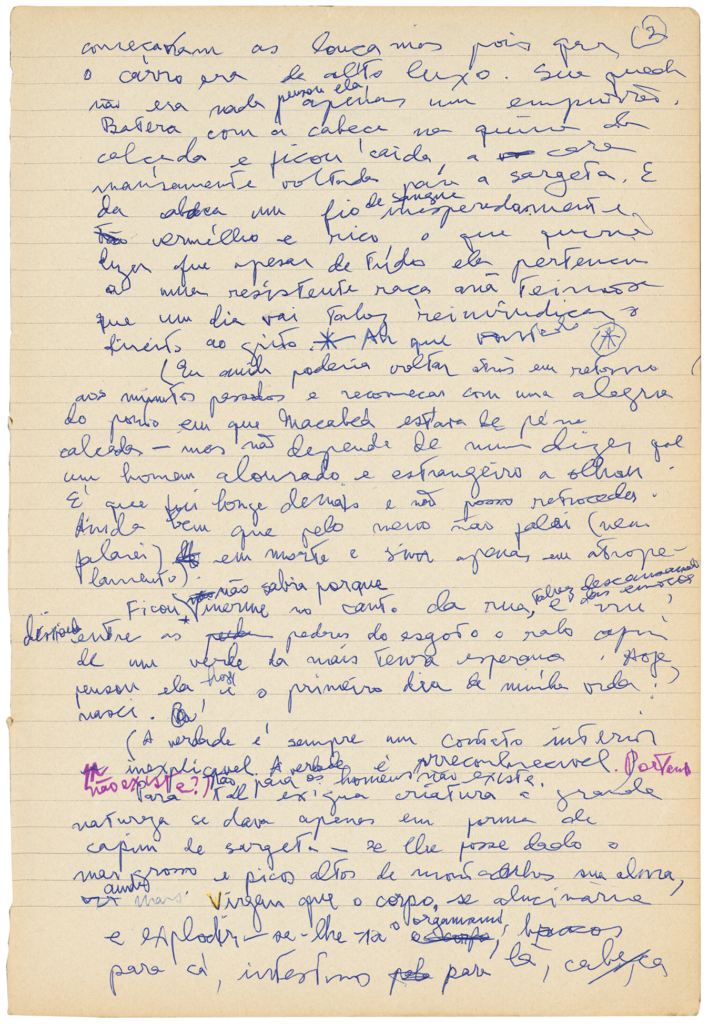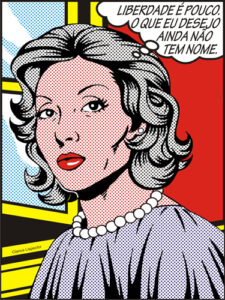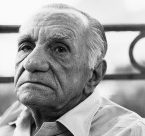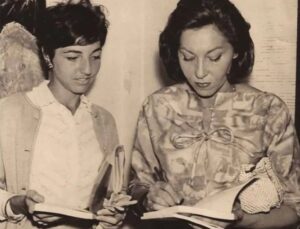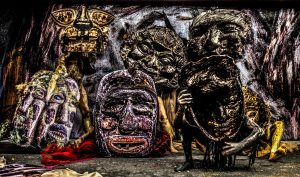, Before the Hour, a preface by Paloma Vidal. IMS Clarice Lispector, 2017. Disponível em: https://site.claricelispector.ims.com.br/en/2017/05/19/antes-da-hora-prefacio-de-paloma-vidal/. Acesso em: 06 December 2025.
To celebrate the 40-year anniversary of The Hour of the Star, the Rocco publishing house has prepared an edition of the novella with a new cover, which will be released at the Travessa Bookstore on May 22 at 7 pm.
The publication includes a new preface by Paloma Vidal based on the research of manuscripts – under the care of the IMS since 2004 and available for access here. We have reproduced a few fragments of this exploration into the collection in the next section.
And now – a chronicle of the encounter with the manuscripts of The Hour of the Star (Paloma Vidal)
A pair of plastic gloves, a box so white it glows, in a small room with glass windows and artificial lighting. It all makes me think of a surgical operation. That’s what I wrote down. Then a question about how to make an emotion arise there. I wrote that down and raised my head, trying not to be seen as I looked at J., sitting at the desk facing mine, busy and vigilant. She was the one who offered me sheets of paper, which were also white, and a pencil, which she sharpened first, in a deliberately old-fashioned gesture. She spends hours inside this room, with lunch and snack breaks, watching how people open and close white boxes, which look like presents, not so much due to their own qualities than to the expectation of those who open them. She’s already seen this gesture so many times she could make a typology: there are those who laugh, those who cry, there are the disdainful and the disrespectful ones, those who roll their eyes, those who close them. There are those who are suspicious, like me. Everything is more or less expected. I wonder how many accept the sheets of paper she kindly offers along with the sharpened pencil, since the use of a computer is allowed. Notebooks and pens, no, computers, yes. (…)
When I arrived at the small room in the Moreira Salles Institute, in Rio de Janeiro, and before opening the white box, I had already seen scanned copies of Clarice Lispector’s notes for The Hour of the Star. Along with the request to write a chronicle of the encounter with the book manuscripts, for a 40th anniversary commemorative edition of the novella, came the images of these papers, which I nonetheless decided I had to see in person. (…)
In this small room, wearing gloves, J. hands me white sheets of paper and a pencil, which I accept, though I had brought my computer. I accept out of courtesy, because it is difficult for me to say no to something that is offered in kindness. But that’s not all: it’s an invitation to write by hand. J. makes me a rare invitation. An invitation, for its part, that could give meaning to this encounter. I would like her gesture to be mine. That’s what I wrote next, before deciding to finally open the white box. (…)
Inside we encounter 34 manila folders of different sizes, numbered on the right, in pencil: 1/34, 2/34, 3/34, and so on. Soon we discover that the size of the folders depends on the size of the papers inside them – smaller when there are loose papers, bigger when there are legal writing pads – and we wonder if they were decorated by hand, custom-made. We also discover that the handwritten titles at the center of the folder covers correspond to the first words on the first page of the manuscripts contained in them. All this presupposes someone’s manual labor. “An archive presupposes an archivist, a hand that collects and classifies,” writes Arlette Farge in The Allure of the Archives. I think of these hands while I handle the folders, which I do not open yet. I think that this archive presupposes many hands, before mine own. And that many others will come, in search of this survival, this trace of the real, as alive as it is inaccessible. (…)
I write by hand on the white sheets of paper that J. gave me, and I’m already somewhere else, while I copy what I wrote down on this computer screen. I end up disobeying the archive, wanting to be faithful to it. (…)
“The allure of the archive,” writes Farge, “passes through this slow and unrewarding artisanal task of re copying texts, section after section, without changing the format, the grammar, or even the punctuation. Without giving it too much thought. Thinking about it constantly. As if the hand, through this task, could make it possible for the mind to be simultaneously an accomplice and a stranger to this past time and to these men and women describing their experiences.”
I go ahead. I feel like I can’t get too fixated, expecting each of these notes to give me a revelation. I begin to go quicker through the notes and folders, making small piles that alarm J.: “will you know how to put them back in order?”, she asks me, removing her earphones and breaking the silence that had apparently been arranged after our roles had been distributed. I answer what she already knows: that the folders are numbered and that, yes, yes, everything is under control. She must have noticed my restlessness. My feeling of unpreparedness. She’s not the first person this has happened to. There are those who know what they want and those who only seek, without knowing where to begin. “How do you start at the beginning, if things happen before they happen?” (…)I jump. The complicity I seek could come from a note in folder 8/34. With very tremulous handwriting, in four lines, without punctuation, Clarice writes on the back of a checkbook: “I swear this/ book is made/ without words/ It is a mute photograph.” The image of the back of the checkbook was not included in the scanned notes I received, and if it weren’t for the later encounter, it would have likely been impossible for me to know the origin of the paper on which these lines were written. In the image, one saw a texture, thin beige lines covering the manila paper, with a slightly darker border. I think of the frequency of these notes in Clarice’s writing, when the words come unexpectedly, when the need to jot them down comes, at any time, in any place. In these folders, there are envelopes, torn papers, loose sheets, this checkbook. I see the fascination caused by the recording of a writing that comes all of a sudden and can’t be contained. The recording of an instant. Of the instant in which something is created. Besides, of course, the witnessing of a method, that only later, having opened a few more folders, will be possible to see better.
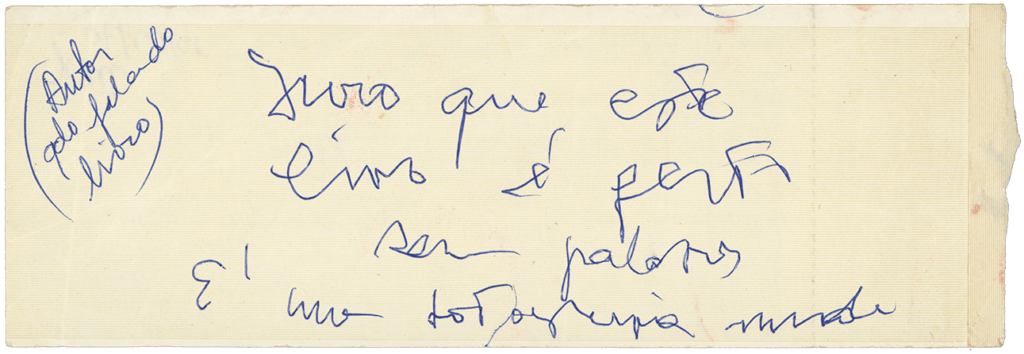
For the time being, I pause at this note. The encounter between these words and this paper. Any type of paper could have served for these notes, I know, including this one, which nonetheless, unlike the others, indicates a date, September 15, 1976, an account number, and a bank branch. “Lido,” of the National Bank. In this specific case, the writing comes to exist in time and in space, in a much more concrete relation to the real of which it is part and of which it has become a trace. It gives visibility to a body, of one who inhabits and passes through a certain place in the city, at a particular time, with its singular characteristics. (…)
On the last pages of the handwritten pad, we arrive at Macabéa’s death. The author makes a detour and the parentheses appear: “(I could turn the clock back and happily start again at the point when Macabéa was standing on the pavement – but it isn’t for me to say whether the fair-haired looked at her with eyes it doesn’t matter what color. But– but I’ve gone too far and there is no turning back. But at least I didn’t speak of death and only being run over.)” How to narrate death is one of the questions that the manuscripts make us see in astonishment. Here is the “grand finale” announced by the author, carefully refuted by the interventions that, in putting the book together, Clarice will make in the continuous text, many of them written down in the fragments that are in these folders. Through them, the book will refute the truth about life being a trajectory that goes from a beginning to an end. The “fatal line” will be cut out. In parentheses, in the book, these opening words are taken up again: “Truth is always an inexplicable inner contact. Truth is unrecognizable.” (…)
